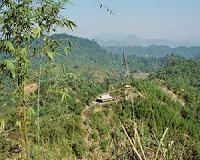| . |  |
. |
Ixtlan De Juarez, Mexico (AFP) Nov 28, 2010 Sweet smelling pine trees and a cloud forest stretch above the town of Ixtlan de Juarez, in the southern Mexican state of Oaxaca, where residents highly value their wood. The Zapotec Indians who share ownership of the land fought for control of the forest from a state company more than 20 years ago. Mexico presents their management of the forest as a model for reducing greenhouse gas emissions, as well as poverty, as negotiators hunker down at global climate talks in Cancun. The United Nations wants breakthroughs from rich nations on verifying deforestation and financing to combat the loss of forests, making woods increasing bargaining chips in the form of carbon credits. In a large sawmill next to the Oaxaca forest, local men and women operate machinery to transport the logs along conveyor belts, capturing shavings before slicing them into planks. "I think that looking after the forest is the main priority for the community because the truth is that our forest gives work to most people who live here," said machine operator Julio Garcia Gomez. The community benefits from a program handing rights and responsibility to forest dwellers, with some financial backing, including from the government. It is run by a committee of 390 people who put management decisions to vote and oversee six companies dedicated to the wood business, from transport to making furniture. Operating with a kind of market socialism, the companies provide direct employment for some 300 people and indirect jobs to 2,000 more in an area of some 5,000 inhabitants. Community leaders say they reinvest some 30 percent of an average 600,000 dollars in annual profits on protecting the forest, including fire-fighting, another 30 percent in the business, and the rest on workers and the community, including in a low-interest credit union and on pensions. Although the companies cut down trees and sell wood, they control logging and replanting to maintain diverse forest cover in the area of some 20,000 hectares (50,000 acres). "The old trees don't process oxygen anymore, they no longer serve to capture carbon, that has to be done by young trees," said Pedro Torres Perez, president of the commission of communal ownership. Thousands of new seedlings are planted each year, while carbon is stored in the wood furniture produced from older trees. Community forest management could capture carbon more effectively than any other effort to slow deforestation, such as industry plantations or protected areas, according to international forestry experts. Despite highly-publicised programs to plant more trees, many of which do not survive, and a decline in deforestation in the past five years, Mexico is still losing its forests to degradation and deterioration. Those losses represent around 10 percent of its greenhouse gas emissions. Although more than seventy percent of Mexico's forests are owned or managed by local communities, less than half have effective management programs. Experts say certain conditions are necessary for them to work. These include: "clear rights regarding the owners, an organization that is well managed, transparently. And also there has to be a policy which really generates skills and resources to develop operations," said Ivan Zuniga, from the Mexican Civic Council for Sustainable Forestry. The community, which also manages eco-hotels, aims to keep reducing its dependence on government aid, as the search continues for the best ways to manage the world's forests to try to slow the warming of the planet. Communal management can be complicated and such projects require dedication, Torres said. "It took a long time, a lot of sacrifice and a lot of people, the work of many people," he said.
Share This Article With Planet Earth
Related Links Forestry News - Global and Local News, Science and Application
 Developing Countries Often Outsource Deforestation
Developing Countries Often Outsource DeforestationStanford CA (SPX) Nov 26, 2010 In many developing countries, forest restoration at home has led to deforestation abroad, according to a new study in the Proceedings of the National Academy of Sciences (PNAS). The authors say their findings could have significant implications for ongoing efforts to protect the world's remaining forests, which are disappearing at an annual rate of more than 32 million acres - an area roug ... read more |
|
| The content herein, unless otherwise known to be public domain, are Copyright 1995-2010 - SpaceDaily. AFP and UPI Wire Stories are copyright Agence France-Presse and United Press International. ESA Portal Reports are copyright European Space Agency. All NASA sourced material is public domain. Additional copyrights may apply in whole or part to other bona fide parties. Advertising does not imply endorsement,agreement or approval of any opinions, statements or information provided by SpaceDaily on any Web page published or hosted by SpaceDaily. Privacy Statement |